Mars appears to be a dry world now, but there are plenty of signs on the planet’s surface that there was once plenty of water, including dry river beds, ancient ocean and lake beds, and valleys carved by water. Significant reserves of water ice have also been discovered on Mars, such as huge polar ice caps, buried glaciers closer to the equator, and near-surface ice permeated by the Martian soil.
Wind-blown piles of dust or layers of ice? ESA’s Mars Express has revisited one of Mars’ most mysterious sites to clarify its composition. The results of the study indicate that layers of water ice extend several kilometers underground – the largest volume of water ever discovered in this part of the planet. More than 15 years ago, Mars Express explored the Medusa Fossa Formation (MFF), discovering massive deposits up to 2.5 km deep. It was unclear from these early observations what these sediments were made of, but new research has now provided an answer.
“We reexamined the MFF using new data from Mars Express’s MARSIS radar and found that the deposits were even thicker than we thought: up to 3.7 km,” says Thomas Watters from the Smithsonian Institution in the US. “It’s amazing that the radar signals match what we would expect to see from layered ice, and are similar to the signals we see from the polar caps of Mars, which we know are very ice-rich.” If melted, the ice trapped in the MFF would cover the entire planet with a layer of water 1.5 to 2.7 m deep: this is the largest volume of water ever discovered in this part of Mars, and enough to fill Earth’s Red Sea.
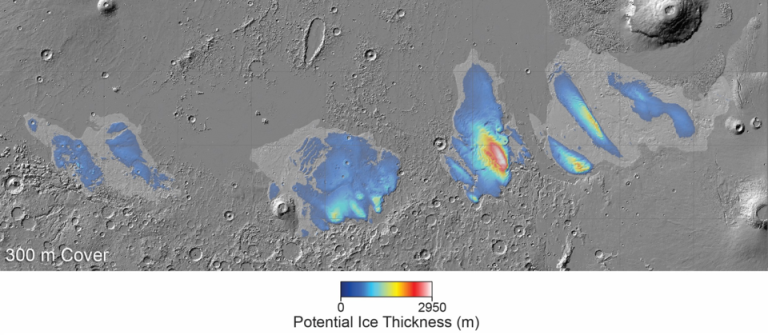
The Medusa Fossa Formation (MFF) consists of several wind-driven features measuring hundreds of kilometers across and several kilometers high. Situated on the boundary between the highlands and lowlands of Mars, these formations are perhaps the largest source of dust on Mars and one of the most extensive deposits on the planet.
Initial observations from Mars Express showed that MFF is relatively transparent to radar and low in density, both characteristics seen in icy sediments. However, scientists could not rule out a more arid version: in fact, these formations are giant accumulations of wind-blown dust, volcanic ash or sediment.
“This is where the new radar data comes in handy! Given how deep it is, if the MFF were just a giant pile of dust, we would expect it to compact under its own weight,” says co-author Andrea Cicchetti from the National Institute of Astrophysics, Italy. “This would create something much denser than what we actually see in MARSIS. And when we modeled how different antifreeze materials would behave, nothing replicated the properties of MFF—we needed ice.” Instead, the new findings suggest layers of dust and ice covered by a protective layer of dry dust or ash several hundred meters thick.
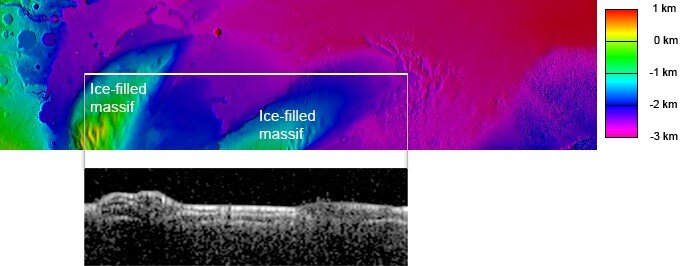
Although Mars now appears to be an arid world, the planet’s surface is full of signs that it once had plenty of water, including dry river beds, ancient ocean and lake beds, and valleys carved by water. Significant reserves of water ice have also been discovered on Mars, such as huge polar ice caps, buried glaciers closer to the equator, and near-surface ice permeated by the Martian soil. Vast reserves of ice near the equator—such as those believed to lie beneath the dry surface of the MFF—could not have formed in the planet’s current climate. They must have formed in a previous climatic epoch.
“This latest analysis challenges our understanding of the formation of Medusa’s pits and raises as many questions as it answers,” says Colin Wilson, ESA project scientist for Mars Express and ESA’s ExoMars Trace Gas Orbiter (TGO). “How long ago did these ice deposits form and what was Mars like at that time? If these massive deposits are confirmed to be water ice, it will change our understanding of Mars’ climate history. Any reservoir of ancient water would be an interesting target for human or robotic exploration.”
“Unfortunately, MFF deposits are covered in hundreds of meters of dust, making them inaccessible for at least the next few decades. However, every piece of ice we find helps us better understand where Mars’ water used to flow and where it can be found today. Together, our Mars explorers are learning more and more about our planetary neighbour,” adds Colin.

While Mars Express images water ice at depths of several kilometers, the view of near-surface water is provided by the TGO Mars orbiter. The orbiter carries the FREND instrument, which maps hydrogen – an indicator of water ice – in the topmost meter of Martian soil. In 2021, FREND discovered a hydrogen-rich region the size of the Netherlands in Mars’ Valles Marineris and is currently mapping the distribution of shallow sediments across the Red Planet.
China’s Tianwen-1 orbiter spotted a massive dust storm on Mars near Mount Olympus, the largest mountain in the solar system. A massive dust storm was captured by the MoRIC medium resolution camera on Tianwen-1 in January 2022. The mission launched in July 2020 and arrived in orbit around Mars shortly before the arrival of NASA’s Perseverance rover in February 2021.
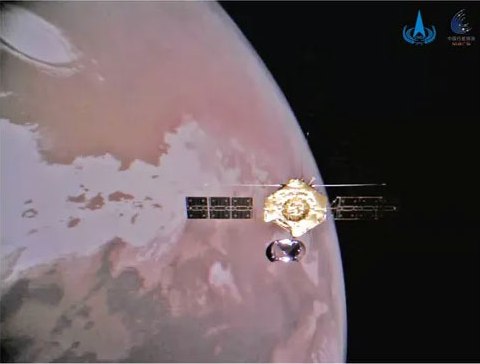
In January 2004, NASA’s twin rovers Spirit and Opportunity landed on opposite sides of Mars, ushering in a new era of interplanetary robotic exploration. They arrived three weeks apart, each surrounded by a cluster of airbags that bounced around the surface about 30 times before stopping and deflating. Mars rovers mission: searching for evidence that water once flowed on the surface of the Red Planet.
Their discoveries would rewrite science textbooks, including that of Opportunity, shortly after the discovery of the famous “blueberries” – spherical pebbles of the mineral hematite formed in acidic water. A few years into the mission, Spirit discovered traces of ancient hot springs that may have been ideal habitats for microbial life billions of years ago (if they ever existed on the Red Planet).
Thanks in part to scientific data collected by Spirit and Opportunity, NASA approved development of the SUV-sized Curiosity rover to investigate whether life-supporting chemical ingredients were present billions of years ago on what was once a water world (shortly after landing in 2012 the rover found this to be the case). Perseverance, which arrived on the Red Planet in 2021, builds on Curiosity’s success by collecting rock cores that could be returned to Earth to test for signs of ancient microbial life as part of the Mars Sample Return Campaign, a joint effort between NASA and the European Space Agency.
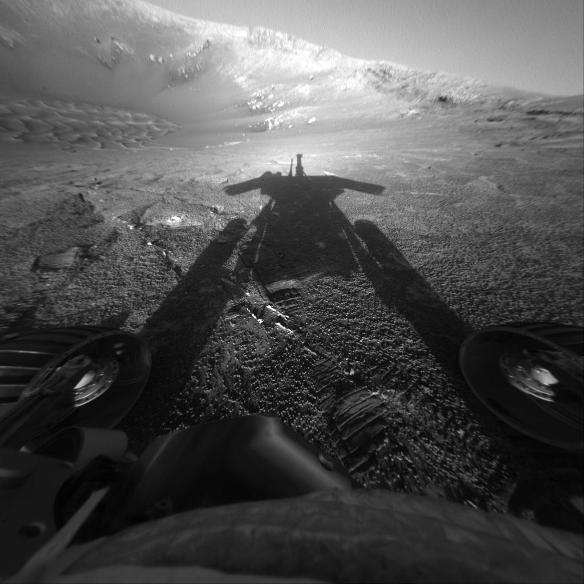
While working on Spirit and Opportunity, engineers developed surface exploration techniques that continue today, including the use of specialized software and 3D glasses to better navigate the Martian environment. And after honing years of experience from the twin rovers’ journeys across the rocky, sandy surface of Mars, engineers can plan safer, longer trips and quickly create the much more complex daily plans needed to operate Curiosity and Perseverance.
Instead, thanks to their long-lived robots, the team was able to travel across a wide variety of Martian landscapes. Opportunity, the first rover to complete a marathon on another planet, will ultimately cover a total of nearly 30 miles (45 kilometers), the furthest distance traveled on another planet.
“This was a paradigm shift that no one expected,” said former project manager John Callas of JPL. “The distance and time scale we covered was truly a historic leap.” The chance to see so much was crucial to the discovery that not only was Mars once a more watery world, but also that it supported many different types of aquatic environments—fresh water, hot springs, acidic and salty pools—at different times moments of its history.
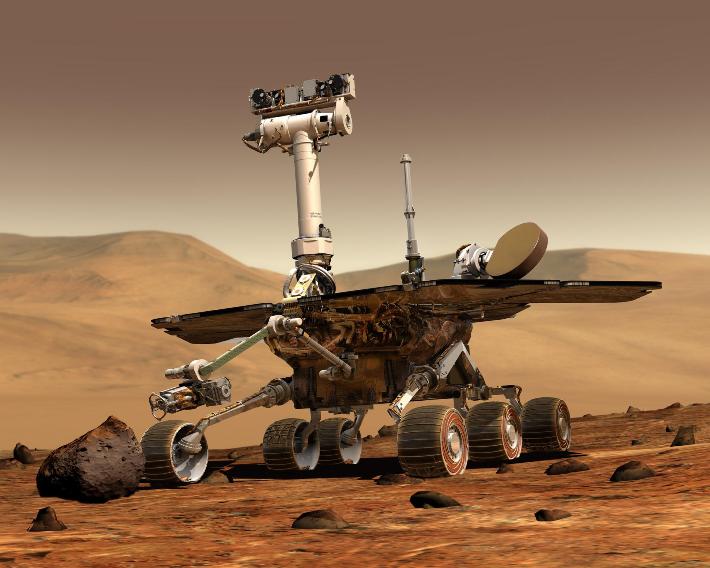
NASA has now selected a team of four volunteers to participate in a simulated journey to Mars in a habitat at the agency’s Johnson Space Center in Houston. Abhishek Bhagat, Kamak Ebadi, Susan Hilbig and Ariana Lucic will enter the HERA (Human Exploration Research Analog) ground facility on Friday, January 26, to live and work as astronauts for 45 days during a simulated mission to the Red Planet. The crew members will leave the facility on March 11, after they “return” to Earth. Two additional volunteers are available as reserve crew.
Without leaving Earth, HERA allows scientists to study how crew members adapt to the isolation, confinement and work conditions that astronauts will encounter on future spaceflights. Crew members will perform scientific, operational and technical tasks while encountering communication delays with the outside world lasting up to five minutes as they “closer” to Mars.
The new crew will take part in 18 human health studies during the simulated mission. The experiments will evaluate the psychological, physiological and behavioral responses of crew members millions of miles from their home planet. Ten studies are new to HERA, including seven conducted by researchers outside the United States. These international studies are carried out in collaboration with the Mohammed bin Rashid Space Center in the United Arab Emirates and ESA (European Space Agency).




